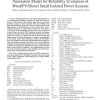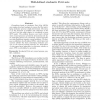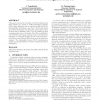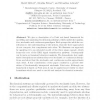106
click to vote
TSMC
2010
14 years 7 months ago
2010
This paper introduces a new general methodology for the modeling and reliability evaluation of small isolated power systems, which include wind turbines, photovoltaics, and diesel ...
107
click to vote
FMCO
2009
Springer
14 years 10 months ago
2009
Springer
This paper reviews the model of interactive Markov chains (IMCs, for short), an extension of labelled transition systems with exponentially delayed transitions. We show that IMCs a...
118
Voted
INFORMS
1998
15 years 5 days ago
1998
High-level formalisms such as stochastic Petri nets can be used to model complex systems. Analysis of logical and numerical properties of these models often requires the generatio...
117
Voted
MASCOTS
1996
15 years 1 months ago
1996
Formalisms based on stochastic Petri Nets (SPNs) can employ structural analysis to ensure that the underlying stochastic process is fully determined. The focus is on the detection...
101
click to vote
FORTE
2004
15 years 1 months ago
2004
The main goal of this paper is to extend sPBC with the iteration operator, providing an operational semantics for the language, as well as a denotational semantics, which is based ...
WSC
2007
15 years 2 months ago
2007
The paper presents an extensible Petri Net Markup Language (xPNML), which is an extended version of PNML. The xPNML format overcomes limitations associated with PNML structure for...
110
click to vote
CPE
2000
Springer
15 years 4 months ago
2000
Springer
Abstract. This paper presents TimeNET, a software tool for the modelling and performability evaluation using stochastic Petri nets. The tool has been designed especially for models...
115
click to vote
VALUETOOLS
2006
ACM
15 years 6 months ago
2006
ACM
This paper proposes the modeling of technical systems and their behavior by means of Unified Modeling Language (UML) State Machines and the extending UML Profile for Schedulabil...
128
click to vote
IEEEARES
2006
IEEE
15 years 6 months ago
2006
IEEE
Failure diagnosis in large and complex systems is a critical task. A discrete event system (DES) approach to the problem of failure diagnosis is presented in this paper. A classic...
123
Voted
CMSB
2007
Springer
15 years 6 months ago
2007
Springer
We give a description of a Petri net-based framework for modelling and analysing biochemical pathways, which unifies the qualitative, stochastic and continuous paradigms. Each per...




